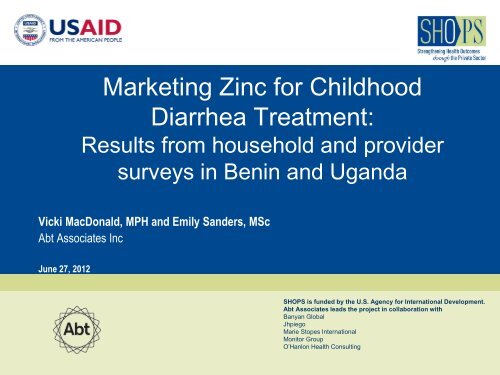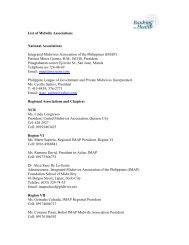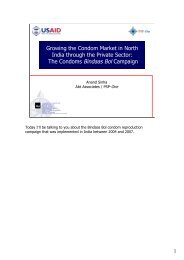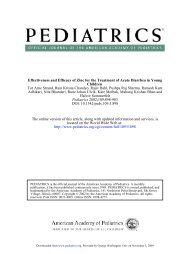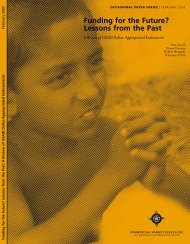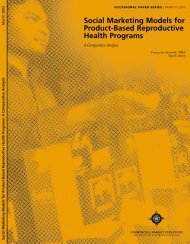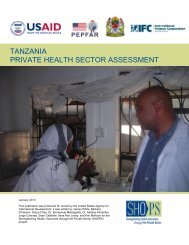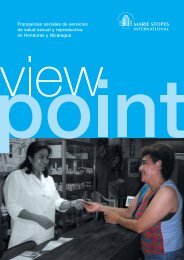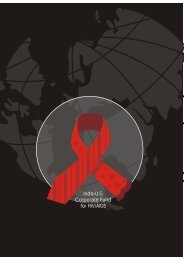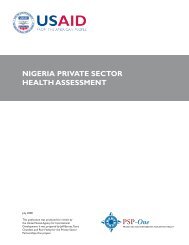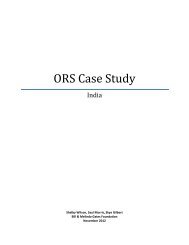Overview of Benin and Uganda Provider Survey ... - SHOPS project
Overview of Benin and Uganda Provider Survey ... - SHOPS project
Overview of Benin and Uganda Provider Survey ... - SHOPS project
Create successful ePaper yourself
Turn your PDF publications into a flip-book with our unique Google optimized e-Paper software.
Marketing Zinc for ChildhoodDiarrhea Treatment:Results from household <strong>and</strong> providersurveys in <strong>Benin</strong> <strong>and</strong> Ug<strong>and</strong>aVicki MacDonald, MPH <strong>and</strong> Emily S<strong>and</strong>ers, MScAbt Associates IncJune 27, 2012<strong>SHOPS</strong> is funded by the U.S. Agency for International Development.Abt Associates leads the <strong>project</strong> in collaboration withBanyan GlobalJhpiegoMarie Stopes InternationalMonitor GroupO’Hanlon Health Consulting
Background• In 2007 the POUZN <strong>project</strong>, implemented by Abt Associates Inc. <strong>and</strong> PSI,collaborated with the government <strong>of</strong> <strong>Benin</strong> to introduce OraselZinc into themarketplace through private sector channels. Orasel Zinc is a diarrheatreatment kit containing ten 20 mg tablets <strong>of</strong> zinc sulfate <strong>and</strong> two sachets <strong>of</strong>orange flavored low osmolarity ORS. It is the only zinc product for diarrheatreatment available in <strong>Benin</strong>.• In Ug<strong>and</strong>a, the AFFORD <strong>project</strong>, implemented by Johns Hopkins Center forCommunication Programs in partnership with the Ug<strong>and</strong>a Health MarketingGroup (UHMG), launched the Zinkid (zinc tablets) <strong>and</strong> Restors (ORSsachets) products for diarrhea treatment in 45 AFFORD <strong>project</strong> districts. Thegovernment <strong>of</strong> Ug<strong>and</strong>a <strong>of</strong>fers a separate zinc product supplied by UNICEFfor public facilities.
Methodology• Caregiver survey – multi-stage sampling approach• In <strong>Benin</strong>, survey carried out in 8 communes, distributed among the 7<strong>project</strong> departments while in Ug<strong>and</strong>a, survey was carried out in a sample<strong>of</strong> 20 districts r<strong>and</strong>omly selected from the 45 UHMG <strong>project</strong> districts.• 392 caregivers were selected from 3,196 sampled households in <strong>Benin</strong><strong>and</strong> 803 out <strong>of</strong> 3,425 caregivers sampled were selected in Ug<strong>and</strong>a.Participants were selected through door-to-door screening, data werecollected on one child under five (aged 0-59 months in <strong>Benin</strong> <strong>and</strong> 6-59months in Ug<strong>and</strong>a) with diarrhea in the 2 weeks preceding the survey.• <strong>Provider</strong> survey• Conducted in same areas as household surveys.• Convenience samples <strong>of</strong> providers were selected. In <strong>Benin</strong>, a total <strong>of</strong> 60public <strong>and</strong> private sector providers were interviewed (30 pharmacy agents<strong>and</strong> 30 nurses/midwives). In Ug<strong>and</strong>a, 71 public <strong>and</strong> private sectorproviders were interviewed (44 doctors/clinical <strong>of</strong>ficers/nurses <strong>and</strong> 27chemists/pharmacists).
Caregiver Knowledge, Attitudes <strong>and</strong>Practices
Zinc use rates were substantially different in<strong>Benin</strong> <strong>and</strong> Ug<strong>and</strong>a.ZincORSHome-prepared solutionIntravenous fluidAntidiarrhealAntibioticInjectionOther pill/syrupNo treatment4.61.328.313.25.116.631.929.713.26.91816.223.29.53943.254.357.50 10 20 30 40 50 60 70 80 90 100% <strong>of</strong> all children <strong>Benin</strong> % <strong>of</strong> all children Ug<strong>and</strong>a5
% <strong>of</strong> caregiversCorrect use <strong>of</strong> zinc with ORS was high in bothcountriesDiarrhea Treatment Using Zinc Among Children Underfive1001008060547565402004.6Treated with zincZinc users thatalso treated withORS18Zinc users thattreated for full 10days<strong>Benin</strong> caregiversUg<strong>and</strong>a caregivers
Inappropriate treatments were widely used, <strong>and</strong> manytimes given in conjunction with zincZincORS<strong>Benin</strong>44.147.56164Children with complicateddiarrheaChildren with uncomplicateddiarrheaAntidiarrhealAntibiotic *13.621.11936.60 20 40 60 80 100Ug<strong>and</strong>aZinc4.25.2ORSAntidiarrhealAntibiotic42.234.43330.335.848.40 20 40 60 80 100Respondents may report multiple choices so the summay exceed 100%; Complicated diarrhea is defined 7 asdiarrhea with fever, a bloody stool, or both.*Statistically significant at p
Health providers in both the public <strong>and</strong> private sectors aremain sources <strong>of</strong> zinc <strong>and</strong> play an important role inencouraging initial use <strong>of</strong> zinc.• Public health clinics were the primary source <strong>of</strong> zinc (43percent in Ug<strong>and</strong>a <strong>and</strong> 56 percent in <strong>Benin</strong>). The privatesector was the second largest source: in <strong>Benin</strong> 37percent <strong>of</strong> caregivers received zinc from pharmacies orprivate clinics/sellers, while in Ug<strong>and</strong>a 35 percent <strong>of</strong>caregivers received zinc from private clinics/sellers.• Many caregivers who treated with zinc were first timeusers (70 percent in Ug<strong>and</strong>a <strong>and</strong> 42 percent in <strong>Benin</strong>).Most first-time zinc users in both countries said that theyused zinc because it was recommended by a provider (85percent in Ug<strong>and</strong>a <strong>and</strong> 67 percent in <strong>Benin</strong>).8
Zinc use was associated with better perceptions <strong>of</strong> price<strong>and</strong> access to productsUg<strong>and</strong>a<strong>Benin</strong>% agreeing with statementDrug stores nearby always havezinc for saleZinc treatments are difficult to getaround hereThere is a place nearby where youcan get zinc when your child needsit% <strong>of</strong> zinc users% <strong>of</strong> nonusers<strong>of</strong>zinc% <strong>of</strong> zincusers% <strong>of</strong> nonusers<strong>of</strong>zinc29.1 23.2 56.9* 22.8*60.5* 77.6* 36.4 18.949.9* 29.6* 76.6* 44.2*Don’t know where to get zinc 7.3* 49.9* 18.4* 36.4*Zinc treatments are too expensive 37.2* 62.1* 21.5 18.5Zinc treatment products areavailable within walking distance <strong>of</strong>54.6* 28.5* 78.4* 43.6*your homeTotal number <strong>of</strong> caregivers 22 151 59 23*Statistically significant difference between users <strong>and</strong> non-users <strong>of</strong> zinc (p
% <strong>of</strong> zinc usersCaregivers hear zinc messages from a variety <strong>of</strong> sources,<strong>and</strong> recall <strong>of</strong> messages about zinc is strongly associatedwith zinc use.% <strong>of</strong> zinc usersUg<strong>and</strong>a100100<strong>Benin</strong>808072.160604020017.2Heard message aboutZinkid2.6Did not hear messageabout Zinkid40200Heard Orasel Zincmessage39.1Did not hear Orasel ZincmessageStatistically significant different between zinc users <strong>and</strong> non-users in both countries (p
<strong>Provider</strong> Knowledge, Attitudes <strong>and</strong> Practices
Inappropriate co-prescription <strong>of</strong> antibiotics with zinc/ORSwas high in both countries.Primary treatment recommended for childhood diarrhea (1 st recommended)• In <strong>Benin</strong>, over half (58 percent) <strong>of</strong> providers that recommended Orasel Zinc as aprimary treatment also recommended a second treatment with an antibiotic (Flagyl)• In Ug<strong>and</strong>a, <strong>of</strong> the few providers that primarily recommened zinc (or zinc plus ORS),half also recommended co-treatment with antibiotics.
Caregiver requests may influence providerdiarrhea treatment behavior.• Most providers report that caregivers request specificmedications.• In <strong>Benin</strong>, providers said the most common treatmentsrequested by caregivers were ORS (84 percent), OraselZinc (50 percent), <strong>and</strong> antibiotics (36 percent).• In Ug<strong>and</strong>a antibiotics (58 percent) <strong>and</strong> antidiarrheals (40percent) were the most requested treatments.• 65 percent <strong>of</strong> providers who recommended antibiotics/antiparastics(including Flagyl/metronidazole) as their primary diarrhea treatment alsostated that caregivers commonly requested antibiotics.• When asked their reasons for not recommending zinc, 21 percent said itwas because “caregivers prefer antibiotics.”
% <strong>of</strong> providers that agree/disagree<strong>Provider</strong> knowledge <strong>and</strong> attitudes about zinc areinconsistent.100%92%<strong>Benin</strong>80%77%60%40%20%8%23%47%53%53%47%% Agreed% Disagreed0%Zinc should begiven with ORSZinc can bestopped whendiarrhea subsidesZinc should begiven with FlagylZinc is only anutritionalsupplement
% <strong>of</strong> providers that agree/disagree<strong>Provider</strong> knowledge <strong>and</strong> attitudes about zinc areinconsistent.100%Ug<strong>and</strong>a80%60%40%20%56%43% 42%35%33%25% 26%22%18%50%26%24%% Agreed% Disagreed% Don't Know0%Zinc is only anutritionalsupplementZinc treatmentcan stop whendiarrhea stopsZinc should begiven withantibioticZinc should beGiven withantidiarrheal
What would motivate a provider torecommend zinc?• <strong>Provider</strong>s who had ever recommended zinc said it was because “it is themost effective treatment for childhood diarrhea” (75 percent in <strong>Benin</strong> <strong>and</strong> 77percent in Ug<strong>and</strong>a).• When asked what it would take for them to recommend zinc plus ORS as theprimary treatment for diarrhea, most said: “knowing zinc is an effectivetreatment for diarrhea” (92% in <strong>Benin</strong> <strong>and</strong> 76% in Ug<strong>and</strong>a).• In <strong>Benin</strong>, 80 percent <strong>of</strong> providers also said that “knowing that zinc is a safeproduct” would be convincing, <strong>and</strong> in Ug<strong>and</strong>a 45 percent said it would help tohave “information about the merits <strong>of</strong> zinc over antibiotics/antidiarrheals”• Data suggests that although providers recall this message they are still notentirely convinced <strong>of</strong> zinc’s effectiveness.
<strong>Provider</strong>s are aware <strong>of</strong> zinc <strong>and</strong> learn aboutzinc through multiple channels• In both countries, most providers (86-88 percent) saidthey had heard <strong>of</strong> zinc as a treatment for diarrhea.• The largest percentage <strong>of</strong> providers (75 <strong>and</strong> 47 percentrespectively) said they had learned about zinc viatelevision or radio, followed by medical/drugrepresentatives (53 <strong>and</strong> 25 percent) <strong>and</strong> continuingmedical education sessions (49 <strong>and</strong> 36 percent).• Most providers recalled a message that zinc was an“effective treatment for diarrhea” (69 <strong>and</strong> 78 percent)followed by it “reduces duration/severity <strong>of</strong> diarrhea” (62<strong>and</strong> 33 percent).
% <strong>of</strong> providersTraining in diarrhea management did not appear toinfluence diarrhea management knowledge <strong>and</strong> practices.<strong>Benin</strong> <strong>Provider</strong>s100%80%95% 93% 95%90%80%93% 93%75%60%40%TrainedNot trained20%0%Give AdviceLook for dangersignsHeard <strong>of</strong> zincas diarrheatreatmentRecommendOraselZinc asprimarytreatment
% <strong>of</strong> providersTraining in diarrhea management did not appear toinfluence diarrhea management knowledge <strong>and</strong> practices.Ug<strong>and</strong>a <strong>Provider</strong>s100%96%95%100% 100%84%88%80%60%40%58%45%TrainedNot trained20%0%Give AdviceLook for dangersignsHeard <strong>of</strong> zinc asdiarrhea treatmentEver recommendzinc
Perception <strong>of</strong> price <strong>and</strong> availability <strong>of</strong> zinc productsin stock are associated with prescribing behavior• Nearly all providers in <strong>Benin</strong> <strong>and</strong> Ug<strong>and</strong>a (96-97 percent) carryproducts for childhood diarrhea treatment. Far fewer (68 <strong>and</strong> 41percent respectively) stock/sell diarrhea treatment productscontaining zinc.• No providers in <strong>Benin</strong> were concerned about price <strong>of</strong> zinc. However,half (50 percent) <strong>of</strong> providers in Ug<strong>and</strong>a who sold zinc products wereconcerned about the pricing. Most (75 percent) were concerned thatthe retail price was too high. <strong>Provider</strong>s reported the retail price <strong>of</strong> zincas between UGX 2,000 <strong>and</strong> 3,000 (USD $0.82 - 1.23) per 10 tablets.• Full course <strong>of</strong> treatment with Flagyl is 1,500 UGX (USD$0.60) for 3tablets x 5 days.
Conclusions <strong>and</strong> Lessons Learned1. Co-packaging <strong>of</strong> zinc <strong>and</strong> ORS may increase correct use<strong>of</strong> zinc with ORS, but only in certain environments.2. Widespread message dissemination is key to increasinguse <strong>of</strong> zinc; however, more precise messaging is neededaround the correct use <strong>of</strong> diarrhea treatment products.3. <strong>Provider</strong>s may play a critical role in driving use <strong>of</strong> the right(as well as the wrong) treatments for childhood diarrhea.4. Efforts to address supply side drivers <strong>of</strong> zinc use includingappropriate pricing <strong>and</strong> widespread availability <strong>of</strong> zincproducts must accompany dem<strong>and</strong> generation efforts.
Vicki_macdonald@abtassoc.comemily_s<strong>and</strong>ers@abstassoc.comwww.shops<strong>project</strong>.org<strong>SHOPS</strong> is funded by the U.S. Agency for International Development.Abt Associates leads the <strong>project</strong> in collaboration withBanyan GlobalJhpiegoMarie Stopes InternationalMonitor GroupO’Hanlon Health Consulting


